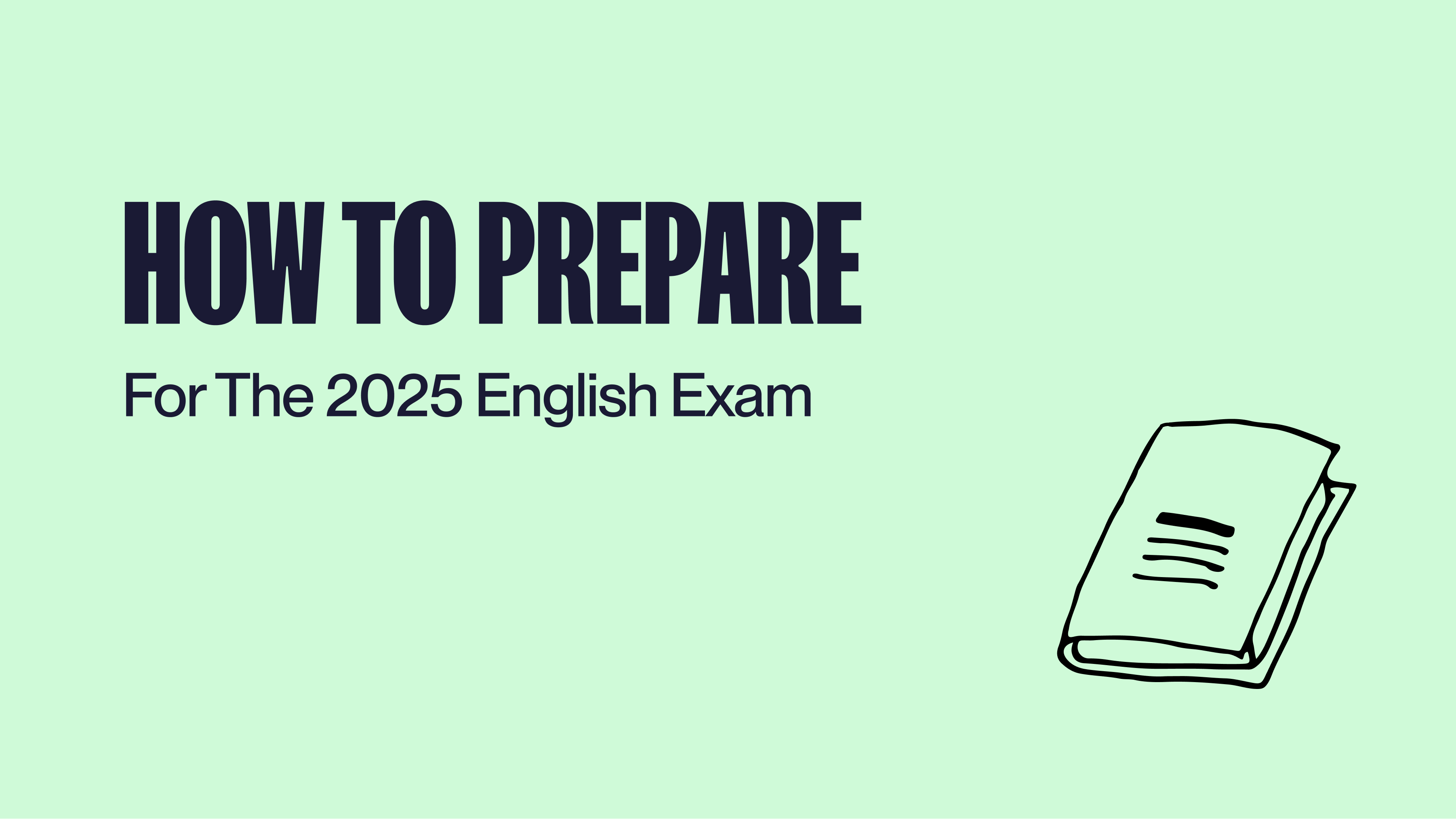
8 Things That Took Me from B+ to Premier’s Award in English
Scoring highly in VCE English is hard. With droves of students vying for a 45+, misleading rumours about what examiners do and don’t want circulating school halls, and conflicting advice on how to best prepare for the 3-hour exam marathon, it’s no surprise that students become overwhelmed.
Unlike many STEM-oriented subjects, English is not an exact science. Students can’t rely on memorisation of content, nor on learning watertight formulae to put into play once the exam hits their desk. The subject naturally involves a level of variability and creativity, and requires an ability to adjust to the articles and prompts at hand with a level of fluency and precision.
Going into year 12, I found myself at a B+ level. Maths and Sciences were my forte, and so I found myself reaching for whatever templates and methods my teachers offered as a means to formularise the subject. Ignoring the inevitable speculation surrounding what curveballs the exam would throw, I instead sifted through past exams and examiners reports to decipher patterns in Argument Analysis articles, and common points which were consistent in the assessors’ feedback.
Ultimately, this approach paid dividends. I finished the year with a raw 50 and a Premiers Award in English, which proved crucial to my achieved a perfect ATAR. Now, having spent years working with students, I’ve identified the common pitfalls students fall into and the tips which set them on the path to a 45+.
1. Learning templates is very possible
I’ll be the first person to caution against memorising analysis for both the text response and argument analysis. In fact, students who recite full paragraphs (and ignore the nuances of the exam’s prompt or article) will inevitably cap their potential study score. That said, workshopping and remembering analyses of text response quotes throughout the year will ensure a fluent and hard-hitting analysis under the pressure of a timed assessment. Generally, I would only bother memorising a quote if I memorised one or two sentences of analysis with it - of course, with blanks where references to the specific exam prompt would be inserted.
The same applies to the argument analysis. I walked into the exam armed with intricate analysis of common language techniques (see tip 2) and tried and tested introduction templates. In fact, I cover this in my Masterclass, introduced here!
TLDR: This is a masterclass divided into 14 simple yet high-yield bite-sized modules, giving you all-time access to a framework I developed with the LVCET team, turning Argument Analysis into digestible systems and templates.
Where students go wrong is being inflexible with these templates - remaining agile to the prompt served up is key to ensuring that assessors don’t mark you down.
2. Argument analysis article are predictable
Okay, this is true only to some degree. The article’s format and topic will invariable differ year-to-year, but some things stay unchanged. For one, the article provided are always jam-packed with language which is ripe to analyse. This makes your selection of what techniques to analyse crucial.
Even more pertinently, there are some language techniques which appear in almost all English argument analysis articles in recent years. It’s these techniques which I focused on practiced for heading into exam day, honing in on my ability to both identify the technique and prepare a flexible template of analysis for. I cover these techniques in Modules 12 to 14 of my course on argument analysis.
3. Clone and adapt for Crafting Texts
Newly introduced to the study design this year (2024), Crafting Texts is polarising—loved by a select few, dreaded by the rest. While the task at hand is open-ended, the key to securing the top marks lies in specificity and precision. You should spend most of your preparation time smashing out 2-3 excellent creative scripts that are both versatile, that is, can be adapted to a range of different exam stimuli, and refined, informed by the broader frameworks and mentor texts.
Put simply, you can prepare and memorise 2-3 creative scripts to adapt to exam stimuli. Practice and exposure is everything. Here's an example of how you can do this for the Protest framework.
4. Showcase your ability to get nitty-gritty
This goes for both the text response and argument analysis. Assessors love a student’s willingness to analyse connotations of individual words or phrases. This is feedback which is common across all recent years.
Extracting the emotion out of the word, or referring to the context in which we typically find the phrase, exhibits one’s ability to examine language on a granular level, something showcased by only the top students. As a result, achieving such a level of writing requires practice and guidance - I cover the analysis of connotation for argument analysis in Module 7 of the online on-demand course, one of the course’s more length sections (such is its importance).
5. Consider evidence as building blocks of a larger construction
Along with the previous point, following this tip will lock in your status as a well-rounded analyser with the ability to dissect on a micro level, and link back to the broader authorial intent. Students regularly fall into the trap of analysing both quotes and languages in isolation, without reference to how it buys back to what the author is trying to contend.
In argument analyses specifically, earning to see how language is designed to both connect with and position its readers takes effort. However, with time, the most well-versed students begin to see evidence as a means of manipulating an author’s relationship with its audience. Again, I cover this in depth in Module 10 of the course.
6. Putting yourself in the author’s shoes is paramount
Investing time into understanding the author as much as the text is the hallmark of a top student, and something which is inevitably favoured by those marking your work. In the text response, spending time researching the social context of the novel’s publication will prove worthwhile in your links back to authorial intent - one of the key pillars in this section’s criteria. Seeing stories and articles as products of the society they’re written in is routinely encouraged in examiner’s reports.
I personally enjoyed investigating the social conditions in which my text response novel Frankenstein was written, and it was my habit of linking evidence back to Mary Shelley’s world view that earned me top marks in that section.
7. Balance the analysis of quotes with construction
Like many of the pointers in this article, this tip applies to both the text response and argument analysis. The sheer number of lines you write during the marathon that is Year 12 somehow distills down to 3 hours worth of writing in the final exam. Naturally, students should aim to offer a variety of evidence and analysis to the assessor.
As such, your ability to recall and dig into ‘construction’ as a form of evidence becomes important. In the text response, construction refers to the more high-level or macro ways that writers push their agenda - some common examples include motifs, chapter structure, selection of protagonist and use of first person. Construction is similarly relevant in the argument analysis, and so is touched on throughout the linked course.
8. Prepare a verb playbook
Finally, one move which settled my nerves going into exam day was the curation of a verb playbook. Throughout the year, I collated a set of ‘analysis’ verbs which I’d picked up from my teacher and from top level students of years prior. These are the verbs which sit in between the evidence and your subsequent analysis.
Selecting appropriate verbs will elevate your piece’s fluency and potency. Because of this, I categorise this pre-prepared set of verbs into distinct buckets. This is something I cover in depth in Module _ of my course on argument analysis.
Final remarks
So there you have it. Whilst you still have some way to go in your Year 12 journey, I can say adhering to these tips will set you on the path to success. The common theme of my advice is giving yourself as many ‘knowns’ as possible on exam day. 3 hours is undoubtedly too long for anyone to continuously churn out fresh new analysis to a 45+ standard, and so walking in with solid structures, flexible templates and nifty turns of phrase will do a world of good.
You probably noticed my propensity to talk of the text response and argument analysis as one of the same - in many ways, they are. Of course the format differs, but both challenge a student’s turn-of-phrase and depth of analysis.
If you got something out of this article, consider watching the almost 2.5 hours of content offered in this argument analysis course, put together by me in collaboration with Lindsey’s VCE Tutoring. The lessons are intended as an extension, and designed to provide the tools. for students to stand out from the pack.



